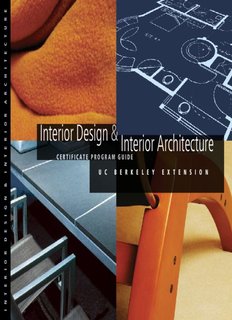‘Interior Architecture’ PDF Quick download link is given at the bottom of this article. You can see the PDF demo, size of the PDF, page numbers, and direct download Free PDF of ‘Interior Design’ using the download button.
Interior Design And Interior Architecture PDF Free Download

Interior Design
Subtractive color is the result of mixing pigments, dyes, or other colorants.
The apparent color of a surface is based on what part of the visible spectrum of light is absorbed versus what portion is reflected back to the viewer.
Since the main concern of this book is the color of interior finishes and not lighting, the focus will be on subtractive, rather than additive, color.
The primary subtractive colors are red, yellow, and blue.
These are called primary colors because all other colors are derived from some combination of these three.
When all three primary colors are combined in equal amounts the resulting color is a deep, blackish brown.
Note that the primary colors are spaced exactly equidistant from one another on the color wheel.
Midway between each primary color is what is called a secondary color.
When two adjacent primary colors are mixed together they form the secondary color found between them on the color wheel.
For example, yellow and blue paint mixed together makes green.
The other secondary colors are orange (red and yellow combined) and purple (red and blue combined).
When adjacent primary and secondary colors are mixed, they form tertiary colors.
Between each of the six, primary and secondary colors are the tertiary colors consisting of red-orange, orange-yellow, yellow-green, green-blue, blue-purple, and purple-red.
When a very consistent, fine pattern of two distinct colors is viewed from a slight distance, the eye tends to mix the colors optically and derive a third color. This is called partitive color.
The principles of additive color are most critical in theater or another dramatic lighting.
For the purposes of interior color design, it is important to understand the effect of artificial lighting on the perception of color.
Analysis is relevant at two related but distinct parts of the project cycle: In the very earliest stages, before in-depth design work takes place, the designer will need to assess the scale and complexity of the project work to be undertaken.
Th is will allow preliminary estimates to be made of the time and resources needed to complete the project, and these
will in turn provide a foundation upon which the designer can base a fee proposal.
Part of the work at this stage will involve determining the scope of the project and the likely format and content of the presentation, as this will control,to a large degree, the amount of drawings and visuals that are prepared, all of which take time that will need to be charged to the client.
Following this and once the client has agreed to the proposed design work being undertaken to reach the first presentation stage, the designer can take an in-depth brief from the client.
Initial examination of the brief, allied to a general understanding of the project, will give the designer a starting point for further research.
All of this work will lead to the second tranche of analysis, in which the designer is aiming to edit, distil and ultimately make sense of all the information that has been gathered.
Some of the information will relate to the practical aspects of the brief, some to the aesthetic, some of which could be contradictory in nature.
Over time, the designer will become used to sett ing priorities and reaching a comfortable compromise with regard to confl icting information.
It is very rare to find a project that does not need some element of compromise to succeed, but there is never one single way to deal with it.
Each project must be looked at on its own merits, and decisions reached that refl ect the unique nature of that project.
Once analysis is complete, conclusions regarding style and content of the project can be summarised by creating
a concept. Th is will then be used to generate ideas and drive the project.
Different methods of analysis and concept styles are looked at in greater detail in the next chapter.
| Writer | – |
| Language | English |
| Pages | 24 |
| Pdf Size | 3.6 MB |
| Category | Art |
| Sources | uop.edu.jo |
Interior Architecture Pdf Free Download
